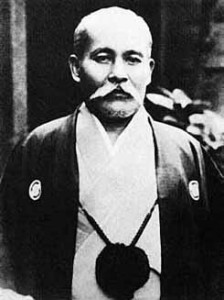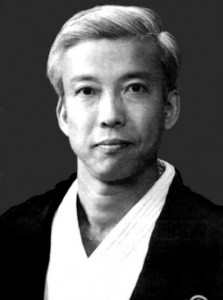 Morihei Ueshiba (1883 – 1969) developed aikido in the early 1900s after many years of research, practice and development. As a youth Ueshiba Sensei, or O-Sensei (Great Teacher) as he was called, applied himself to many arduous years of training in Budo (Japanese martial arts) learning jujutsu, the spear, staff, Daito Ryu Aiki Jujutsu, and enjoyed the reputation of being unbeatable with the sword.
Morihei Ueshiba (1883 – 1969) developed aikido in the early 1900s after many years of research, practice and development. As a youth Ueshiba Sensei, or O-Sensei (Great Teacher) as he was called, applied himself to many arduous years of training in Budo (Japanese martial arts) learning jujutsu, the spear, staff, Daito Ryu Aiki Jujutsu, and enjoyed the reputation of being unbeatable with the sword.
Although he became very strong, O-Sensei was troubled with the idea that winning at someone else’s expense was not really winning. O-Sensei came to realise that true self-defence was winning over the discord within yourself. Though an acknowledged master, O-Sensei continued to practice strenuously and Aikido was born as a way to avoid harm while not inflicting permanent injury on an aggressor. Aikido is clearly not only an effective self-defence and healthy exercise but also a way (do) to understand conflict in society.
The present site of the Aikikai Foundation in Tokyo is the cradle of Aikido. The Aikikai Foundation is the head office of the International Aikido Federation, the world centre for developing Aikido and the only Aikido organisation recognised by the Japanese Ministry of Education. The position of Ni-Dai Doshu [2nd Headmaster] was assumed by Kisshomaru Ueshiba in 1969 upon the death of O-Sensei. Doshu became the President of the International Aikido Federation in 1976 at its first congress. Mr Kisshomaru Ueshiba passed away on 4 January 1999. O-Sensei’s grandson Mr Moriteru Ueshiba assumed the position of San-Dai Doshu in February 1999.
Aikido is unique among Japanese martial arts because as suggested by the name which means “the way of spiritual harmony”, it brings the attacker under complete control by blending with his oncoming force. Aikido is an effective self-defence, and healthy exercise beneficial to everyone.
Aikido and Other Budo (Martial Arts)
“What is the difference between Aikido and Judo? And what about Karate?”
These questions are always asked during Aikido demonstrations.
Of course there are technical differences which become clear during training. Generally speaking, we say that Judo employs techniques of holding at the sleeves or collar and takes advantage of opportunities to throw the opponent. In Aikido, the moment of contact (ki-musubi) is the decisive time for action; there is no grappling or jostling with each other.
In Karate the differences are even clearer. In general, Karate utilises thrusting and kicking, mostly in straight lines, though circular movements are also included. Aikido does have thrusting and straight-line movements, however the essence of Aikido technique lies in circular and spherical motion.
Movements in Aikido can be more commonly found in Japanese swordsmanship than in other martial arts. O-Sensei did make the point, however, that those who study Aikido, if holding a weapon, must manoeuver according to Aiki principles.
Aikido, if performed correctly, should not simply be a training in forms (kata). Rather, Aikido should be infinitely versatile, the technique mirroring the situation, timing, power and feeling of the attack.
Aikido is not a sport or competition. Rather training is always conducted with a partner but we work together to achieve the common aim of improving ourselves.
Aikido and Self Defence
The techniques of Aikido are used for self-defence in the following ways:
- Using natural circular motions to harmonise with the attacker’s force and subdue him.
- Controlling an attacker through vulnerable points on his body.
- The use of “ki” or “Kokyu Ryokyu” (breath control) developed through training.
Aikido and Health
Correct and diligent training improves the general condition of the body including the skeletal structure and joints, breathing and blood circulation. The fitness and positive mental attitude developed from training assists in everyday life.


